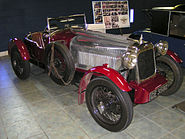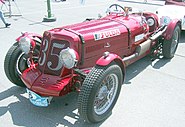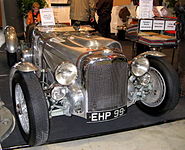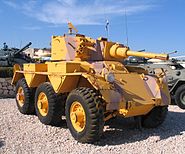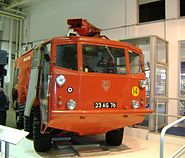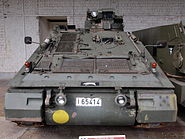|
Alvis logo.png Alvis for Individuality | |
| Former type | Private company |
|---|---|
| Industry | Automotive industry |
| Successor(s) | Rover Company |
| Founded | Coventry, England 1919 |
| Founder(s) | Thomas George John |
| Defunct | 1967 |
| Headquarters | Coventry, England |
| Number of locations |
Production locations: Coventry, England: |
| Area served | Worldwide |
| Key people |
Thomas George John Chief Engineer, Aero Engine Division, 1922 – 1972 |
| Products | Automobiles, military vehicles, aircraft engines |
| Website | www.alviscars.co.uk/alviscars.php |
| References: [1] | |
Alvis Car and Engineering Company Ltd was a British manufacturing company in Coventry, England. From 1919–1967 in addition to automobiles designed for the civilian market, the company also produced racing cars, aircraft engines, armoured cars and other armoured fighting vehicles.
After becoming a subsidiary of Rover in 1965, car manufacturing was ended but armoured vehicle manufacture continued. Alvis became part of British Leyland and then in 1982 was sold to United Scientific Holdings which renamed itself Alvis plc
History of the company[]

1923 12/40 open two-seater

1927 12/50 Sportsman's 2-door saloon

1928 12/75 Front Wheel Drive
open two-seater T.T. replica

1933 Crested Eagle drophead coupé

1938 4.3 Litre sports saloon
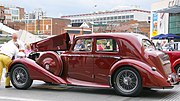
1939 Speed 25 sports saloon
Early history[]
The original company, T.G. John and Company Ltd., was founded in 1919 by Thomas George John (1880 – 1946). Its first products were stationary engines, carburetors and motorscooters. Following complaints from the Avro aircraft company whose logo bore similarities to the original winged green triangle, the more familiar inverted red triangle incorporating the word "Alvis" evolved. On December 14, 1921, the company officially changed its name to The Alvis Car and Engineering Company Ltd. Geoffrey de Freville (1883 – 1965) designed the first Alvis engine and is also responsible for the company name.[1]
The origin of the name Alvis has been the subject of a great deal of speculation over the years. Some have suggested that de Freville proposed the name Alvis as a compound of the words "aluminium" and "vis" (meaning "strength" in Latin), or perhaps it may have been derived from the Norse mythological weaponsmith, Alvíss. De Freville however vigorously rejected all of these theories. In 1921, he specifically stated that the name had no meaning whatsoever, and was chosen simply because it could be easily pronounced in any language. He reaffirmed this position in the early 1960s, stating that any other explanations for the source of the name were purely coincidental.[1]
Production was relocated to Holyhead Road in Coventry, where from 1922 to 1923 they also made the Buckingham car. In 1922 George Thomas Smith-Clarke (1884 – 1960) left his job as assistant works manager at Daimler and joined Alvis as Chief Engineer and Works Manager. Smith-Clarke was accompanied by William M. Dunn, who also left his job as a draughtsman at Daimler to become Chief Draughtsman at Alvis. This partnership lasted for nearly 28 years and was responsible for producing some of the most successful products in the company's history. Smith-Clarke left in 1950, and Dunn assumed Smith-Clarke's position as Chief Engineer, remaining in that position until 1959.[1]
De Freville's first engine design was a four-cylinder engine with aluminium pistons and pressure lubrication, which was unusual for that time. The first car model using de Freville's engine was the Alvis 10/30. It was an instant success and established the reputation for quality workmanship and superior performance for which the company was to become famous. The original 10/30 side-valve engine was improved, becoming by 1923 the overhead valve Alvis 12/50, a highly successful sports car which was produced until 1932. Around 700 of the 12/50 models and 120 of the later Alvis 12/60 models survive today.[citation needed]
1927 saw the introduction of the six-cylinder Alvis 14.75 and this engine became the basis for the long line of luxurious six-cylinder Alvis cars produced up to the outbreak of World War II. These cars were elegant and full of technical innovations. Independent front suspension and the world's first all-synchromesh gearbox came in 1933 followed by servo assisted brakes. The Alvis 12/75 model was introduced in 1928, a model bristling with innovation, such as front-wheel drive, in-board brakes, overhead camshaft and, as an option, a Roots type supercharger.[citation needed]
As with many upmarket engineering companies of the time, Alvis did not produce their own coachwork, relying instead on the many available coachbuilders in the Midlands area, such as Carbodies, Charlesworth Bodies, Cross and Ellis, Duncan Industries (Engineers) Ltd, E. Bertelli Ltd, Grose, Gurney Nutting, Hooper, Lancefield Coachworks, Martin Walter Ltd, Mayfair, Mulliners, Tickford, Vanden Plas, Weymann Fabric Bodies, and William Arnold Ltd. Several cars also survive with quite exotic one-off bodywork from other designers such as Holbrook, a U.S. coachbuilder.[2]
In 1936 the company name was shortened to Alvis Ltd, and aircraft engine and armoured vehicle divisions were added to the company by the beginning of World War II. Smith-Clarke designed several models during the 1930s and 1940s, including the six-cylinder Speed 20, the Speed 25, and the Alvis 4.3 Litre model.[1]
Second World War[]
Car production was initially suspended in September 1939 following the outbreak of war in Europe, but was later resumed and production of the 12/70, Crested Eagle, Speed 25, and 4.3 Litre continued well into 1940. The car factory was severely damaged on November 14, 1940 as a result of several bombing raids on Coventry by the German Luftwaffe, although ironically the armaments factory suffered little damage. Much valuable cutting gear and other equipment was lost and car production was suspended for the duration of the war, only resuming during the latter part of 1946. Despite this, Alvis carried out war production on aircraft engines (as sub-contractor of Rolls-Royce Limited) and other aircraft equipment.[1]
Post war[]

1948 Fourteen drophead coupé-cabriolet
Car production resumed with a four-cylinder model, the TA 14, based on the pre-war 12/70. A solid, reliable and attractive car, the TA 14 fitted well the mood of sober austerity in post war Britain, but much of the magic attaching to the powerful and sporting pre-war models had gone and life was not easy for a specialist car manufacturer. Not only had Alvis lost their car factory but many of the prewar coachbuilders had not survived either and those that had were quickly acquired by other manufacturers. In fact, the post war history of Alvis is dominated by the quest for reliable and reasonably priced coachwork.[citation needed]
1950s[]
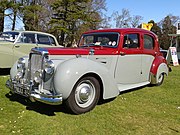
1952 Three Litre sports saloon

Three Litre TC 21/100 Grey Lady
sports saloon
Smith-Clarke himself retired in 1950 and Dunn took over as chief engineer. In 1950 a new chassis and six-cylinder 3 Litre engine was announced and this highly successful engine became the basis of all Alvis models until production ceased in 1967. Saloon bodies for the TA 21, as the new model was called, again came from Mulliners of Birmingham as they had for the TA 14, with Tickford producing the dropheads. But with the first of these committing themselves in October 1954 to supply only Standard Triumph who purchased it in 1958 and the second being acquired by David Brown owner of Aston Martin Lagonda in late 1955, it was becoming clear that new arrangements would have to be made. Some of the most original and beautiful designs on the 3 Litre chassis were being produced by master coachbuilder Carrosserie Herman Graber of Switzerland and indeed these often one-off–designed cars are highly sought after today. Graber had begun to use TA 14 chassis soon after the war building three Tropic coupés which were much admired. When the Three Litre chassis was introduced his bodies displayed at the Geneva Motor Shows in 1951 and 1952 attracted sufficient interest for Graber to set up a standing order of 30 chassis per year. Swiss-built Graber coupés were displayed on the Alvis stand at both Paris and London Motor Shows in October 1955.
With a licence in place, from late 1955 all Alvis bodies became based on Graber designs however few chassis and few bodies were built over the next two years. Around 15 or 16 TC108/Gs were built by Willowbrook Limited of Loughborough and Willowbrook was subsequently taken over by Duple Coachbuilders. Over the same two years Graber built 22 TC 108Gs and complained that if he had received chassis he would have committed himself to buying 20 a year. Only after late 1958 with the launch of the TD 21 did something resembling full-scale production resume as Rolls-Royce subsidiary Park Ward began to build the new bodies now modified in many small ways. These cars, the TD 21 and its later variants, the TE 21 and finally the TF 21 are well built, attractive and fast cars. However it was clear by the mid-1960s that with a price tag of nearly double that of the mass-produced Jaguar, the end could not be far off.[citation needed]
From 1952 to 1955 Alec Issigonis, the creator of the later Mini, worked for Alvis and designed a new model with a V8 engine which proved too expensive to produce.[citation needed]
1960s[]
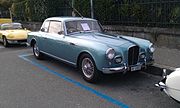
1957 Three Litre TC 108G
fixed head coupé

1967 Three Litre series IV
drophead coupé or cabriolet
Rover took a controlling interest in Alvis in 1965 and a Rover-designed mid-engined V8 coupé prototype named the P6BS was rumoured to be the new Alvis model but with the takeover by British Leyland this too was shelved. By the time the TF 21 was launched in 1966, (available, like its predecessors in both saloon and drophead form and with either manual or automatic gearbox), the model was beginning to show its age despite a top speed of 127 mph - the fastest Alvis ever produced. With only 109 sold and with political troubles aplenty in the UK car manufacturing business at that time, production finally ceased in 1967.
In 1968, a management buyout of the car operations was finalised and all the Alvis car design plans, customer records, stock of parts and remaining employees were transferred to Red Triangle.[citation needed]
1970s to present[]
As part of Rover, Alvis Limited was incorporated into British Leyland but was bought by United Scientific Holdings plc in 1981. Subsequently the company's name was changed to Alvis plc. Alvis plc acquired a British truck manufacturer Universal Power Drives in 1994, naming their new subsidiary Alvis Unipower Limited. The trucks were subsequently branded as Alvis-Unipower. In 1998, Alvis plc acquired the armoured vehicle business of GKN plc, and the main UK manufacturing operation was moved from Coventry to Telford. The site of the Alvis works in Holyhead Road is now an out-of-town shopping complex, but its name, Alvis Retail Park, reflects the heritage of the site. In 2002 Alvis plc purchased Vickers Defence Systems to form the subsidiary Alvis Vickers Ltd, which was in turn purchased by BAE Systems in 2004. BAE Systems ended the use of the Alvis distinctive red triangle trademark.[citation needed]
In 2009, Red Triangledisambiguation needed negotiated the legal transfer of the Alvis car trademarks. The following year, the company announced that the 4.3 Litre Short Chassis tourer would once again be available. All Alvis' records remain intact at the company’s Kenilworth headquarters along with a large stock of period parts. One of the men to have worked on the very last Alvis car produced in 1967 is still retained by Red Triangle in a training capacity. Built to the original plans, the new car has been named the "Continuation Series", to reflect the 73-year interruption in its production between 1937 and 2010. It differs only in detail from the pre-war examples: for emissions, the engine is governed by an electronic fuel injection system with electronic ignition, brakes are hydraulic rather than cable, the steering column collapsible and the rear light arrangement reconfigured to conform to modern standards.[citation needed]
Revived company[]
In the early 21st century a new website launched a retro model from the companys past an agreement between them and BAe as to the revival of the marque,[3]
Alvis automobiles[]
List of most commercial models, 1920 – 1967[]
| Model name | cyl. | disp. | b.h.p. | tax
H.P. |
Body | From | To | Number produced [note 1][4] |
Comments[5] |
|---|---|---|---|---|---|---|---|---|---|
| 10/30[6][7] | 1460 | 10.48 | 2-seater with double dickey, tourer | 1920 | 1923 | side valves | |||
| 11/40[6] | 1598 | 11.40 | 4-seater tourer and a full range of other types | 1921 | 1923 | side valves | |||
| 12/40[6] | 1598 | 11.47 | 1922 | 1925 | side valves | ||||
| 12/50[6][8] | 1496
1598 1645 |
50 52 |
11.47
11.47 11.81 |
2 seat sports, drophead coupé, saloon | 1923
1924 1926 |
1929
1925 1932 |
Types: SA, SB, SD, TF, TH
Type: SC, Types: TE, TG, TJ | ||
| 12/80 | 1598 | 11.47 | 2 seat sports | 1926 | 1926 | cost £1000, guaranteed maximum of 100 mph | |||
| 14.75[6][9][10] | 1870 | 14.75 | Alvista saloon | 1927 | 1929 | Types: SA, TA, TB | |||
12/75[6][11]
|
1481 | 11.40 | Front-wheel drive; 2 seat sports, 4 seat sports, Alvista sports saloon |
1928 | 1931 | Types: short chassis (FA and FD), long chassis (FB and FE)
75 b.h.p. supercharged | |||
Ulster T T[6][12]
|
1491 | 15.00 | Front-wheel drive; 2 seat sports, 4 seat sports | 1928 | 1929 | Guaranteed 95 mph in touring trim, 100 mph in racing trim | |||
| Silver Eagle[6] | 1991
2148 2362 2511 |
72 66 75 |
16.95 | 2 seat sports, coupé, drophead coupé, saloon | 1930
1929 1935 1931 |
1930
1936 1935 1932 |
Type: SD
Types: SA, SE, SF, SG, TA, TB, TC Type: SG Types: SA, TB, TC | ||
| 12/60[13][14] | 1645 | 11.81 | 2 seat sports, 4 seat sports, sports saloon | 1931 | 1932 | Types: TJ, TK, TL | |||
| Speed 20[6] | 2511
2762[15] |
95 |
19.82 | sports tourer, drophead coupé, sports saloon | 1932
1935 |
1934
1936 |
Types: SA, SB
Types: SC, SD | ||
| Firefly[6] | 1496 | 11.81 | 4 light saloon, 6 light saloon, drophead coupé, sports tourer | 1933 | 1934 | Types: SA, SB | |||
| Crested Eagle[6][16][17] | 2148
2511 2762 3571 |
72 77 106 |
16.95
19.82 19.82 25.63 |
4 light saloon, 6 light saloon, limousine | 1933
1933 1935 1937 |
1934
1934 1940 1940 |
Types: TE
Types: TD, TE Types: TF, TG, TJ, TK Types: TA, TB, TC, TD | ||
| Firebird[6] | 1842 | 13.22 | 4 light saloon, 6 light saloon, drophead coupé, sports tourer | 1935 | 1939 | Type: SA | |||
| 3½ Litre[6] | 3571 | 25.63 | chassis | 1935 | 1936 | ||||
| Speed 25[6] | 3571 | 25.63 | sports tourer, drophead coupé, sports saloon | 1936 | 1940 | ||||
| 4.3 Litre[6] | 4387 | 31.48 | sports saloon, sports tourer | 1937 | 1940 | ||||
| Silver Crest[6] | 2362
2762 |
95 |
16.95
19.82 |
Seventeen
4 light saloon, 6 light saloon, drophead coupé |
1937 | 1940 | Type: TF
Type: TH | ||
| 12/70[6] | 1842 | 13.22 | sports tourer, drophead coupé, sports saloon | 1938 | 1940 | Bodies by Mulliners (Birmingham) | |||
| TA 14[6] | 1892 | 13.58 | sports saloon, drophead coupé | 1946 | 1950 | Bodies by Mulliners (Birmingham), coupés by Tickford | |||
| TB 14[6] | 1892 | 13.58 | 2 seater sports | 1948 | 1950 | Body by A P Metalcraft | |||
| TA 21[6] | 2993 | 26.25 | sports saloon, drophead coupé | 1950 | 1953 | Bodies by Mulliners (Birmingham), coupés by Tickford | |||
| TB 21[6] | 2993 | 26.25 | 2 seater sports | 1950 | 1953 | Body by A P Metalcraft | |||
| TC 21[6]
TC 21/100 |
2993 | 100 |
26.25 | sports saloon, drophead coupé | 1953 | 1955 | Bodies by Mulliners (Birmingham), coupés by Tickford | ||
| TC 108G[6] | 2993 | 26.25 | sports saloon | 1955 | 1958 | Bodies by Graber (22) and Willowbrook (15) | |||
| TD 21[6] I & II | 2993 | 26.25 | 2 dr saloon, drophead coupé | 1958 | 1963 | Graber styled bodies by Park Ward, coupés by Tickford | |||
| TE 21[6] III | 2993 | 26.25 | 2dr saloon, drophead coupé | 1964 | 1966 | as TD 21 | |||
| TF 21[6] IV | 2993 | 26.25 | 2dr saloon, drophead coupé | 1966 | 1967 | Production ended September 1967 |
Racing cars[]
Three British car companies—Alvis, Bentley, and Sunbeam—entered vehicles in local racing events between 1920 and 1930. Alvis and Sunbeam were at that time the only British companies building cars to Grand Prix formula racing specifications. Of these, Alvis was the only company whose race cars were characterized by front-wheel drive and fully independent suspension.[18]
Alvis was a pioneer of front-wheel drive vehicles. While J. Walter Christie had designed the first front-wheel drive race car, which he drove in the 1906 Vanderbilt Cup,[19] the next notable front-wheel drive race car was the supercharged Alvis 12/50 racing car designed by G.T. Smith-Clarke and W.M. Dunn, which was entered in the 1925 Kop Hill Climb in Princes Risborough in Buckinghamshire on March 28, 1925. Two months later (on Saturday, May 30, 1925), Harry Arminius Miller's Miller 122 front-wheel drive car was entered in the 1925 Indianapolis 500.[18]
Gallery of racing cars[]
Alvis aircraft engines[]

An Alvis Leonides Mk.173 radial engine as fitted to the Bristol Sycamore helicopter. Note the large fan in front of the cylinders, typical of engines supplied to helicopters.
Alvis first aero-engines were licence built Gnome-Rhone radials. Their first Alvis design was the 14-cylinder Alvis Pelides radial in 1936. It and related development; the Pelides Major, Alcides, Alcides Major and the Maeonides Major engines was stopped with the start of the Second World War. The Alvis Leonides, a smaller 9 cylinder radial, continued in development during the war and was used post war in some aircraft and helicopters until production finished in 1966. In 1952, Alvis returned to 14-cylinder radials with a development of the Leonides as the Leonides Major.[20][21]
Alvis military vehicles[]

An Alvis Stormer ambulance and an FV432 armoured personnel carrier of the 7th Armoured Brigade, 1st United Kingdom Armoured Division, proceed north after crossing the Saudi-Iraq border during Operation Desert Storm
The Hungarian automotive engineer Nicholas Straussler had designed an armoured car (AC1) in 1932, which was built by the Manfred Weiss company under licence in Budapest. When Hungary aligned itself with Germany soon after that, Straussler emigrated to England.[22] Straussler's small new company, Straussler Mechanisations Ltd, lacked the necessary resources and capacity to build the vehicle on a large scale, so Straussler approached Alvis, and Alvis-Straussler Ltd, a short-lived joint venture company, was formed in July 1936.[22][23] The protoype vehicle produced, the Alvis Straussler AC2, was built upon the AC1 chassis. The first AC3—the first operational purpose-built armoured car ever produced[citation needed]—was delivered in 1937 by Alvis-Straussler Ltd, built upon the AC2 protoype.[22] Twenty-seven vehicles were built; 12 for the Royal Air Force, 3 for the Portuguese Army, and 12 for the Royal Netherlands East Indies Army.[23] The AC2 was subsequently used as a basis for the 39M Csaba armoured scout car built for the Royal Hungarian Army during World War II.
- Alvis-Straussler AC3 armoured car (Alvis-Straussler Ltd., 1937)
- Alvis-Straussler light medium tank (Alvis-Straussler Ltd., 1937)
- Hefty gun tractor (Alvis Mechanisation Ltd., 1937)
- LAC armoured car (Alvis Mechanisation Ltd., 1938)
In 1938, Alvis produced a prototype armoured light reconnaissance vehicle for comparison trials with other manufacturers. The Alvis Dingo lost out to a design by BSA Cycles but the Dingo name was adopted as a nickname for the BSA design - as the Daimler Dingo
Post war, Alvis designed a series of six-wheel drive vehicles. The Saladin (FV601) armoured car and Saracen armoured personnel carrier were first. The Saracen was built as a number of related vehicles including FV604 Regimental Command Vehicle, and FV610 Armoured Command Post. The Salamander was an airfield crash tender. It was subsequently used as a basis for the Stalwart amphibious military truck.[24] The FV611 model was also built to serve as an armoured ambulance.[25]
Combat Vehicle Reconnaissance (Tracked) series of tracked armoured personnel carriers The FV432 tracked armoured personnel carrier and related vehicles was developed in the early 1960s by GKN Sankey and came under Alvis in 1998.
The Combat Vehicle Reconnaissance (Tracked) family of tracked vehicles were designed in the 1960s. The family includes the FV101 Scorpion, FV102 Striker, FV103 Spartan, FV104 Samaritan, FV105 Sultan, FV106 Samson, FV107 Scimitar, FV4333 Stormer, and the Streaker.[24] The first vehicle of this series was the FV101 Scorpion, which was the first aluminium hull tank ever to be built. The hull and turret are actually fabricated from a welded aluminium-zinc-magnesium alloy. 17 Scorpion prototypes were delivered for field testing in February 1969.[24]
Gallery of military vehicles[]
Alvis ownership[]
Over 20% of all Alvis cars ever manufactured were still in existence in 1989.[1] The Alvis Owners Club is a club for all Alvis car and military vehicle enthusiasts. It was founded in 1951. It has 1,700 members. It hosts International Weekends annually, where owners from the UK and overseas display their cars. In 2009 it was held at Polesden Lacey.[citation needed]
The Alvis Register is a club with over 600 members, which is dedicated to all things related to vintage Alvis motor cars (1920 to 1932). Members can access technical and historical information and share their interest with other Alvis enthusiasts. Most owners retain an eligible car or cars.[26]
Alvis logo
Notes[]
- ↑ Figures in brackets show those cars that were bodied by Graber out of the number produced. Source TC108/G flash demonstration
References[]
- ↑ 1.0 1.1 1.2 1.3 1.4 1.5 1.6 Day, Kenneth (1989). "Part I: Company history". In Iles, Robert. Alvis:the story of the red triangle (2nd ed.). Somerset, England: Haynes Publishing Group. pp. 10–112. ISBN 0-85429-667-0.
- ↑ Walker, N (1997). A-Z of British Coachbuilders. Bay View Books. ISBN 1-870979-93-1.
- ↑ http://www.alviscars.co.uk/alviscars.php
- ↑ Robson, G (2006). A-Z of British Cars 1945–1980. Devon, England: Herridge & Sons. ISBN 0-9541063-9-3.
- ↑ Day, Kenneth (1989). "Part III: Car specifications and performance data". In Iles, Robert. Alvis:the story of the red triangle (2nd ed.). Somerset, England: Haynes Publishing Group. pp. 164–256. ISBN 0-85429-667-0.
- ↑ 6.00 6.01 6.02 6.03 6.04 6.05 6.06 6.07 6.08 6.09 6.10 6.11 6.12 6.13 6.14 6.15 6.16 6.17 6.18 6.19 6.20 6.21 6.22 6.23 6.24 6.25 6.26 Kenneth Day, Alvis, The Story of the Red Triangle, Haynes, Yeovil 1989 ISBN 0-85429-667-0
- ↑ The Times, Tuesday, Jan 03, 1922; pg. 6; Issue 42919
- ↑ The Times, Tuesday, Mar 15, 1927; pg. 10; Issue 44530
- ↑ The Times, Monday, Sep 19, 1927; pg. 9; Issue 44690
- ↑ The Times, Saturday, Oct 13, 1928; pg. 6; Issue 45023
- ↑ The Times, Friday, Oct 12, 1928; pg. 8; Issue 45022
- ↑ The Times, Monday, Sep 09, 1929; pg. 21; Issue 45303
- ↑ The Times, Saturday, Oct 18, 1930; pg. 17; Issue 45647
- ↑ The Times, Tuesday, Mar 10, 1931; pg. 20; Issue 45767
- ↑ The Times, Thursday, Sep 13, 1934; pg. 8; Issue 46858
- ↑ The Times, Wednesday, Oct 22, 1930; pg. 10; Issue 45650.
- ↑ The Times, Tuesday, Aug 25, 1931; pg. 10; Issue 45910
- ↑ 18.0 18.1 Day, Kenneth (1989). "Part II: Racing history". In Iles, Robert. Alvis:the story of the red triangle (2nd ed.). Somerset, England: Haynes Publishing Group. pp. 113–63. ISBN 0-85429-667-0.
- ↑ "J. Walter Christie". Featured drivers. VanderbiltCupRaces.com. 2011. Archived from the original on 17 July 2011. http://web.archive.org/web/20110717185329/http://www.vanderbiltcupraces.com/index.php/drivers/driver/christie. Retrieved 2011-07-24.
- ↑ Lumsden, Alec (2003). British Piston Engines and their Aircraft. Marlborough, Wiltshire, England: Airlife Publishing. pp. 57–61. ISBN 1-85310-294-6.
- ↑ Day, Kenneth (1989). "Part IV: Aero engines". In Iles, Robert. Alvis:the story of the red triangle (2nd ed.). Somerset, England: Haynes Publishing Group. pp. 257–71. ISBN 0-85429-667-0.
- ↑ 22.0 22.1 22.2 Munro, Bill (2002). "Chapter 1: The Alvis". Alvis Saracen Family. Marlborough, Wiltshire, England: The Crowood Press Ltd. pp. 7–19. ISBN 978-1-86126-537-1.
- ↑ 23.0 23.1 Jost, Jacques (2000). "Alvis-Straussler Armoured Cars in the Netherlands East Indies". Forgotten Campaign: The Dutch East Indies Campaign 1941-1942. Archived from the original on 26 July 2011. http://web.archive.org/web/20110726051603/http://www.dutcheastindies.webs.com/alvis_straussler.html. Retrieved 2011-07-24.
- ↑ 24.0 24.1 24.2 Day, Kenneth (1989). "Part V: Armoured vehicles". In Iles, Robert. Alvis:the story of the red triangle (2nd ed.). Somerset, England: Haynes Publishing Group. pp. 272–95. ISBN 0-85429-667-0.
- ↑ Munro, Bill (2002). "Chapter 4: Saracen development". Alvis Saracen Family. Marlborough, Wiltshire, England: The Crowood Press Ltd. pp. 54–76. ISBN 978-1-86126-537-1.
- ↑ Day, Kenneth (1989). "Part VI: Alvis ownership". In Iles, Robert. Alvis:the story of the red triangle (2nd ed.). Somerset, England: Haynes Publishing Group. pp. 296–341. ISBN 0-85429-667-0.
Further reading[]
- Clarke, RM (1989). Alvis gold portfolio 1919–1967. Cobham, Surrey, England: Brooklands Books. ISBN 978-1-870642-84-2.
- Culshaw, D (2003). Alvis three litre in detail: TA21 to TF21 1950-67. Beaworthy, Devon, England: Herridge and Sons Ltd.. ISBN 978-0-9541063-2-4.
- Padfield, A (2000). "Captain G T Smith-Clarke: automobile and medical engineer". pp. 89–96. PMID 10994055. http://www.wyreforest.gov.uk/FastWEB/FastWEB_Upload/2008/Supporting%20Documents/A%202008%200237%201SD.pdf.
External links[]
| Wikimedia Commons has media related to Alvis vehicles. |
- Alvis Cars Ltd
- Alvis Register
- Red Triangle
- Brief history of Alvis
- History of the Alvis company
- Alvis history
- Alvis cars site
- Alvis fighting vehicles
- Alvis Owners Club
- Alvis cars photos & specs
- Earley Engineering - Alvis Sales and Restoration
The original article can be found at Alvis Car and Engineering Company Ltd and the edit history here.

